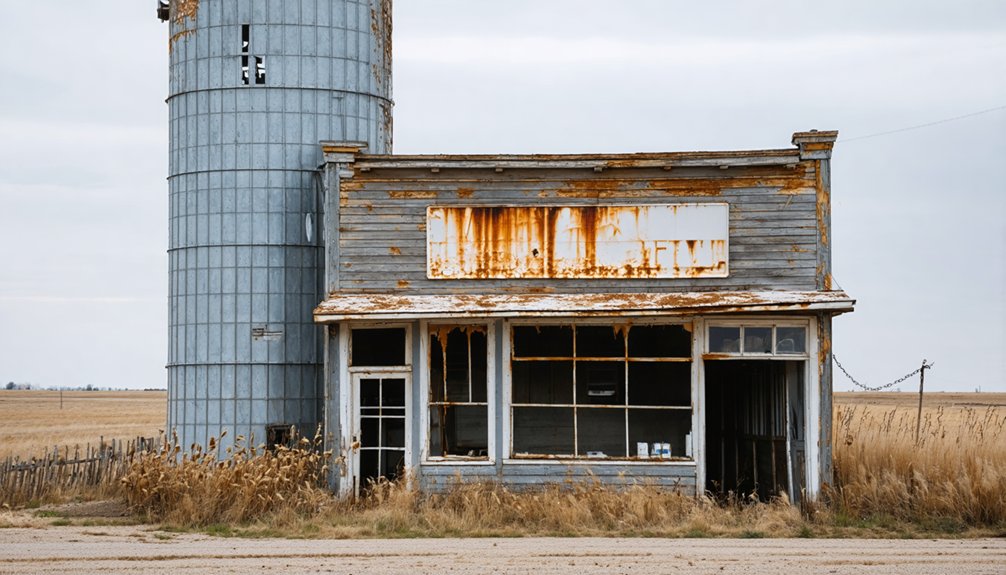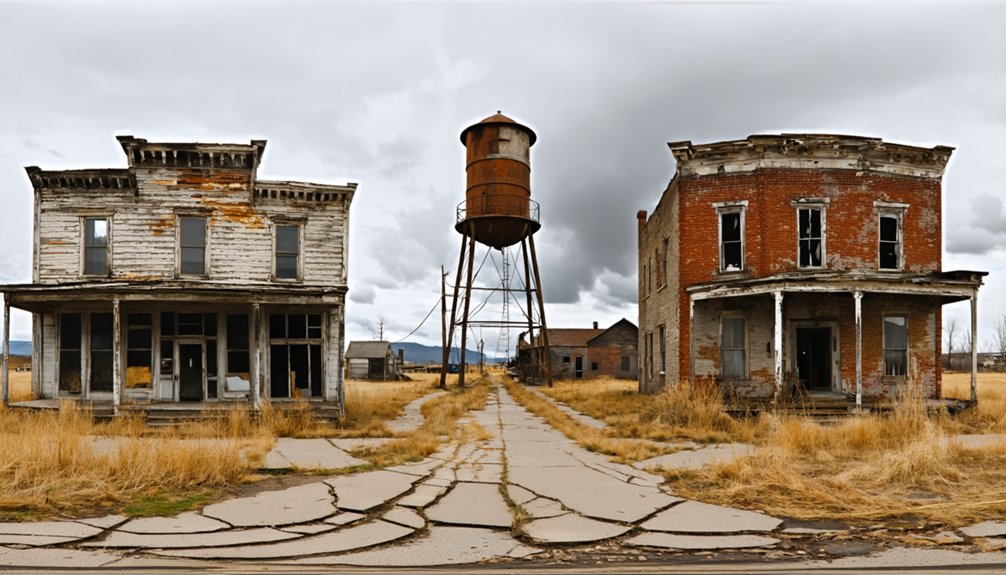You’ll encounter a haunting collection of abandoned Midwest towns, each telling a unique story of American resilience and decline. From Ardmore’s weathered railroad structures to Buxton’s vanished mining community, these sites showcase technological evolution and environmental challenges. You’ll find Victorian-era institutions like the Squirrel Cage Jail, Iowa’s Edinburgh Manor, and Michigan’s copper mining ghost towns, where preserved ruins stand as silent witnesses. These forgotten places hold countless untold stories waiting in their crumbling corridors and empty streets.
Key Takeaways
- Ardmore, established in 1889 along the New Burlington Railroad, now stands abandoned with weathered structures due to water scarcity issues.
- Ghost towns across Kansas feature haunting ruins of stone houses, historic cemeteries, and abandoned grain elevators from frontier-era communities.
- Buxton, Iowa, once the largest coal-mining city west of the Mississippi, now lies abandoned beneath farmland after its mining industry collapsed.
- Edinburgh Manor in Iowa, an abandoned care facility, contains preserved artifacts from 2010 and features a haunting pauper cemetery.
- The Quincy Mine complex in Michigan stands as a preserved ghost town, showcasing abandoned mining structures and extensive underground tunnels.
The Rotating Terror: Squirrel Cage Jail
Among the most unique examples of 19th-century correctional architecture, the Squirrel Cage Jail in Council Bluffs, Iowa stands as a tribute to Victorian-era innovation in prison design.
Built in 1885, this three-story marvel features a revolutionary rotary system of pie-shaped cells that rotate around a central axis – a jail innovation that would influence correctional facilities across America.
You’ll find the building’s ingenious mechanism allowed a single jailer to control all cells from one position, though this efficiency came at a cost to human dignity. The massive rotating cell structure weighed 90,000 pounds when empty.
The Squirrel Cage operated until 1969, holding everyone from moonshiners to murderers within its rotating terror.
Today, as a National Historic Landmark, the structure serves as a museum, where you can explore its haunted corridors and witness the preserved remnants of this unique approach to incarceration. Visitors often report experiencing unexplained noises throughout the building, particularly in the former jailer’s apartment.
Whispers From the Past: Edinburgh Manor
As you explore Edinburgh Manor’s century-long history, you’ll confront the sobering reality of how society once treated its most vulnerable citizens through documented cases of overcrowding, restraints, and patient abuse.
The manor’s stark institutional halls, where personal belongings still remain exactly as they were left in 2010, stand as a preservation-worthy reflection of evolving social welfare practices in America’s heartland. Today, curious visitors can experience paranormal day tours while exploring the haunted facility. The property was purchased by Q Farm Land Trust in 2011, marking the beginning of its transformation into a haunted attraction.
Your journey through this 12,000-square-foot brick edifice reveals not only its shift from poor farm to asylum but also the countless lives forever altered within its walls, where many residents died on-site and were buried in the property’s pauper cemetery.
Dark Treatment Ward History
While Edinburgh Manor promised care for society’s most vulnerable members when it opened in 1911, the facility’s dark history reveals a troubling pattern of neglect and abuse.
You’ll find haunting memories in the segregated wings where overcrowded rooms held the elderly, poor, and mentally disabled residents. The dark legacy of this 12,000-square-foot institution includes reports of patient restraint, sexual assault, and inadequate care from limited staff. The facility followed its predecessor’s grim tradition as the Jones County Poor Farm, where residents were forced to work the land in exchange for shelter.
By the 2000s, the Manor’s reputation had deteriorated further amid scandals of mismanagement and Medicaid fraud. The facility’s documented death toll exceeded 150 souls between 1910 and its closure in 2010, though incomplete records suggest the true number may be higher. The Joker’s spirit is said to still terrorize visitors in the basement and former padded cell.
Today, abandoned medical files and personal belongings still whisper stories of those who suffered within its walls.
Paranormal Activity Reports Today
Since its closure in 2010, Edinburgh Manor‘s abandoned halls have become a focal point for paranormal investigators documenting unexplained phenomena.
You’ll encounter intense activity in the basement, where a malevolent entity known as the Joker creates poltergeist disturbances and high EMF readings that can affect your physical well-being.
Throughout the upper floors, you’ll witness apparitions of a woman in white, wandering shadow figures, and playful child spirits. Recent investigators reported hearing mysterious sounds of whistling between team members, despite this being against standard ghost hunting protocol.
EVP sessions have captured compelling evidence, including voices responding to investigators and unexplained sounds echoing through empty corridors.
The second floor particularly harbors residual hauntings, where tragic events replay themselves independent of human interaction.
Multiple paranormal teams continue to investigate these ghostly encounters, documenting everything from moving objects to aggressive physical contact.
Lives Forever Changed Here
Behind the weathered walls of Edinburgh Manor lie countless stories of lives forever transformed by circumstance and necessity.
You’ll find haunted memories of those who sought refuge here – the elderly, disabled, and mentally ill who called this 12,000-square-foot structure home for nearly a century.
The poor and disabled were forced to work the land in exchange for shelter, creating a dark legacy that haunts the property to this day.
As you walk these halls, you’re treading where forgotten lives once intersected: orphans who grew up within these walls, laborers who worked the Poor Farm fields, and residents who spent their final days in these rooms.
The Medicaid fraud investigation led to widespread changes in management and care practices.
More than 180 souls passed through Edinburgh’s doors never to leave, their remains resting in the pauper’s cemetery or released to family.
The Manor’s sudden closure in 2010 left behind personal belongings and medical records, preserving a stark reminder of society’s most vulnerable members.
Where Steam Engines Rest: Ardmore’s Silent Streets
As you travel along South Dakota Highway 71 near the Nebraska border, you’ll encounter the haunting remnants of Ardmore, a frontier railroad town established in 1889 along the New Burlington Railroad line.
Among the railroad relics, you’ll find a story of survival shaped by water woes – where steam locomotives once stopped for Hat Creek’s acidic water while bringing fresh drinking water to residents.
The harsh reality of frontier life flowed through Ardmore, where trains brought life-giving water while drawing from the creek’s toxic supply.
The town’s fate was sealed when diesel engines replaced steam power, eliminating the need for water stops. Early attempts at dry farming techniques ultimately failed to save the struggling town.
Now silent streets mark where President Coolidge once attended a town picnic in 1927, and where sixteen resilient souls still called home in 1980.
Today, the weathered structures stand as evidence to how technological progress and environmental challenges can reshape frontier dreams.
Copper Kingdom’s Last Stand: Quincy Mine
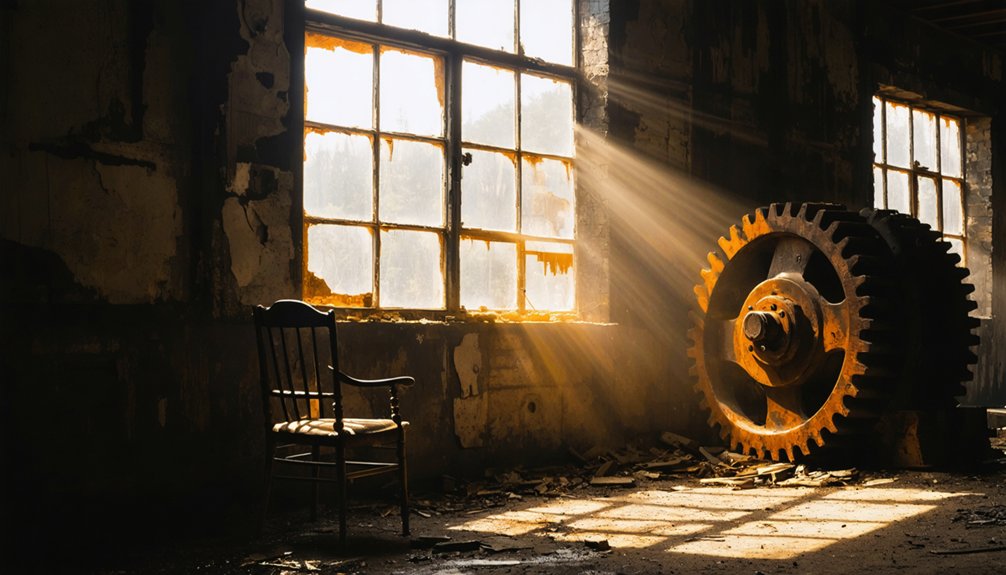
You’ll encounter remarkable feats of underground engineering at the Quincy Mine, where innovative steam-powered drills and hoists helped produce over 800 million pounds of copper during its peak years from 1863 to 1867.
The mine’s technological prowess earned it the nickname “Old Reliable” as it paid consistent dividends for nearly 60 years and survived longer than most operations from Michigan’s first copper boom.
Today, as part of the Keweenaw National Historical Park, you can explore the preserved red-brick hoist house with its distinctive green tile roof and participate in educational tours that showcase this cornerstone of America’s industrial heritage.
Underground Engineering Marvels
When Michigan’s historic Quincy Mine began operations in 1856, it marked the beginning of an unprecedented era of underground engineering innovation in American mining history.
You’ll find engineering advancements that revolutionized the industry, from the first switch to amygdaloid mining to the installation of steam-powered hoists that could lift 2,000 tons of ore daily from depths of 9,240 feet.
The mining infrastructure you’ll discover tells a story of technological triumph.
Steam-powered fans maintained air quality in the deepest tunnels, while compressed air drills and electric lighting improved working conditions.
The mine’s extensive network of tunnels, tramways, and pumping stations showcased the era’s most sophisticated water management systems.
This complex web of innovation made Quincy Mine one of North America’s most advanced copper mining operations.
Peak Production Years
The copper kingdom’s reign at Quincy Mine reached its zenith in 1910, with an astounding output of 458 million pounds of refined copper.
You’ll find that during this golden age, the mining community thrived as “Old Reliable” lived up to its nickname, consistently paying dividends to shareholders from 1868 through 1920.
As you explore the mine’s history, you’ll discover how copper extraction evolved from basic manual tools to advanced hoisting systems.
The shift to mining amygdaloid lodes proved revolutionary, allowing workers to tap into larger, more accessible deposits.
While this period brought prosperity, it also came at a human cost – the region’s mines claimed approximately 1,900 lives.
Despite challenges, Quincy’s peak years were instrumental in America’s industrial growth, providing copper for everything from brass buttons to electrical infrastructure.
Preservation Efforts Today
Thanks to a substantial $1.4 million grant from the Abandoned Mine Lands program, preservation efforts at Quincy Mine have entered an ambitious new phase of restoration.
You’ll find crews working diligently to repair century-old structures, including the No. 2 shaft house where they’ve installed a new roof hatch and replaced the 1908 flagpole with a safer design.
The Quincy Mine Hoist Association, partnering with the National Park Service, oversees these crucial preservation projects while maintaining historical accuracy.
Their work includes stabilizing iron support columns, reinforcing foundations, and repairing the aging Hoist House ceiling.
Community engagement remains central to the site’s mission, with youth work crews participating in hands-on preservation projects.
Through guided tours both above and below ground, you’ll experience firsthand how this industrial heritage site balances preservation with public access.
Gold Rush Ghosts: The Ruins of Garnet
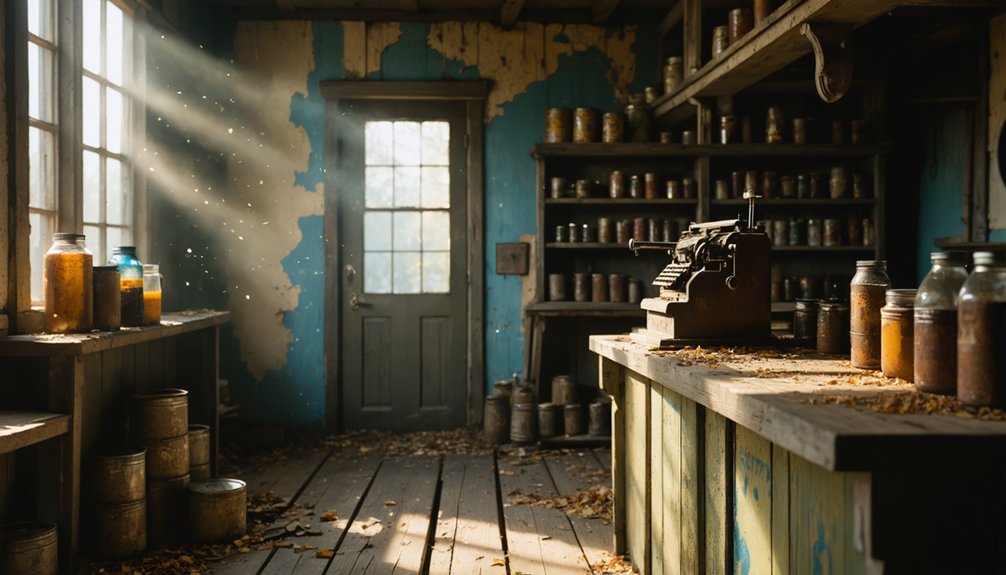
Perched high in Montana’s Garnet Mountain Range at 6,000 feet elevation, Garnet stands as one of America’s most well-preserved gold rush ghost towns.
You’ll find yourself stepping into a mining heritage frozen in time, where original furnishings and artifacts remain exactly as they were left in the 1940s when the last residents departed.
As you explore the town’s remaining structures, you’ll discover thirteen former saloons, a stamp mill, and numerous cabins that tell the story of a once-thriving community of 1,000 residents.
The buildings, constructed without foundations during the 1890s gold rush, now serve as time capsules.
Beyond the historical significance, visitors often report ghostly encounters, particularly in winter when snow isolates these wooden structures that still hold newspapers in their walls as insulation.
Echoes of the Wild West: Bodie’s Frozen Moment
Deep in California’s eastern Sierra Nevada foothills, Bodie stands frozen in time as America’s most authentic Wild West ghost town. Following its 1859 discovery, this legendary settlement transformed from a small mining camp into a booming metropolis of 8,000 residents, producing over $38 million in precious metals during its peak years.
You’ll discover a town preserved in “arrested decay,” where 170 original structures still stand as silent witnesses to Bodie’s notorious past. The Wild West legends of gunfights and lawlessness that earned Bodie its “Badman” reputation now draw visitors seeking authentic frontier experiences.
As you explore abandoned saloons, peek into dust-covered storefronts, and wander past the cemetery’s 150 graves, you’re experiencing a genuine slice of California’s gold rush heritage, officially recognized as a National Historic Landmark since 1961.
Prairie Phantoms: Lost Towns of Kansas
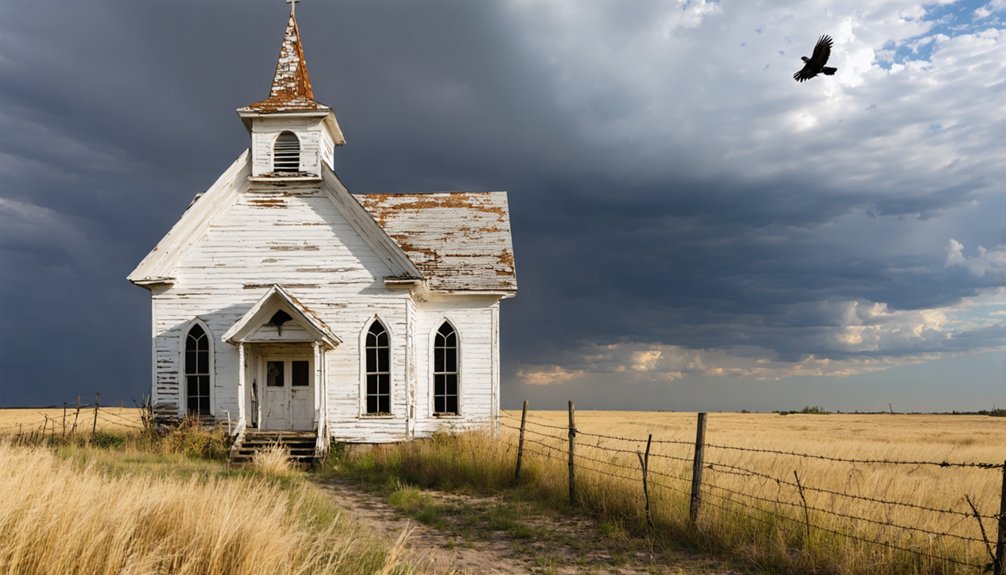
You’ll find Kansas’s abandoned towns scattered across the prairie landscape, from the southeastern mining ruins of Empire City to the weathered homesteads of western settlements like Morton City.
As you explore these forgotten places, you’ll encounter silent symbols to boom-and-bust cycles – abandoned post offices, crumbling stone houses, and preserved schoolhouses that once bustled with life.
Whether examining the well-preserved Potwin Place or the sparse remnants of Monmouth, you’re witnessing the physical record of how economic shifts, agricultural challenges, and changing transportation routes reshaped the American heartland.
Windswept Streets Stand Empty
Across the sweeping Kansas prairie, more than 300 ghost towns stand as silent witnesses to the region’s boom-and-bust cycles.
As you explore these windswept memories, you’ll discover the abandoned echoes of once-thriving communities where dreams dissolved into the harsh realities of economic change.
These remnants of prairie life tell compelling stories:
- Decaying homes and churches slowly surrender to relentless winds
- Grain elevators rise like sentinels above empty streets
- Old cemeteries mark the final resting places of pioneer spirits
- Collapsed factory walls hint at industrial prosperity long past
- Railroad depots, now silent, remind us of essential transportation links
You’re witnessing the aftermath of dramatic population shifts, as towns that once bustled with hundreds of residents during the late 1800s now stand empty or house fewer than fifty souls.
Mining Dreams Gone Cold
When the Missouri, Kansas, and Texas railway first snaked through Southeast Kansas in the late 1800s, it sparked a mining boom that would birth dozens of ambitious settlements.
You’ll find these mining legacies scattered across the landscape, from West Mineral’s massive Big Brutus to Empire City’s transformation into Galena’s Fifth Ward.
These forgotten settlements once bustled with life – their streets lined with banks, schools, and churches.
You can trace their ambitious dreams in what remains: foundation stones, cemetery markers, and scattered ruins.
In West Mineral, where nearly 2,000 people once called home, the last coal was extracted in 1974.
Like many single-industry towns, its fate was sealed when the market collapsed.
Today, these ghost towns stand as silent witnesses to an era when mineral wealth promised endless prosperity.
Ghost Stories Still Echo
Beyond the mining settlements, Kansas’s landscape holds hundreds of lost towns that tell a different story of frontier dreams and failures.
You’ll discover haunting memories in the weathered ruins, where spectral echoes of bustling streets now stand silent. These prairie phantoms persist through preserved landmarks:
- Abandoned stone houses and crumbling foundations mark communities like Prairie City and Monticello
- Historic cemeteries serve as the final proof of vanished populations
- Solitary churches and schoolhouses stand as lone sentinels of lost communities
- Operational grain elevators and railroad tracks hint at once-thriving economies
- Hidden stories captured by photographers and historians keep these places alive
These ghost towns aren’t just relics – they’re crucial chapters in America’s westward expansion, preserved through historical societies and regional tourism efforts that guarantee their legacy endures.
Hidden History: Iowa’s Forgotten Mining Communities

Deep beneath Iowa’s fertile farmland lies a remarkable chapter of American industrial history, where bustling coal-mining communities once thrived and then vanished.
You’ll find forgotten heritage in places like Buxton, once the largest coal-mining city west of the Mississippi, where 10,000 people forged their lives around the mines. These mining legacies tell stories of diverse communities, particularly in Buxton’s unique African American majority population, who built temporary homes, schools, and businesses.
In Buxton, Iowa, African Americans built a thriving coal-mining community, creating a remarkable legacy of diversity in America’s heartland.
Today, you can explore these abandoned sites, though nature has reclaimed most traces of their existence.
The Norwood-White mines near Moran showcase the industry’s dramatic rise and fall, from the discovery of an underground lake to the final flames of a mine fire in 1940.
Underground Secrets: Michigan’s Abandoned Copper Country
Michigan’s Upper Peninsula holds a remarkable collection of copper mining ghost towns, where America’s first mineral rush transformed the rugged Keweenaw Peninsula into a bustling industrial powerhouse.
You’ll discover immigrant communities that shaped these towns, particularly the skilled Cornish miners who brought their deep mining expertise to the region.
- Central Mine grew to 1,300 residents, featuring schools, churches, and a vibrant social life
- Cliff Mine produced over 40 million pounds of copper before its abandonment
- Delaware’s preserved mine tunnels offer glimpses into the past
- Calumet, once Michigan’s wealthiest town, showcases Finnish heritage
- Hand-hewn log cabins still stand after a century, evidence of pioneers’ craftsmanship
Today, these ghost towns serve as open-air museums, where you can explore stone foundations, mine shafts, and restored buildings that tell the story of America’s copper mining legacy.
Ghost Stories Along the Great Lakes
Along the shores of the Great Lakes, abandoned towns harbor more than just empty buildings – they hold stories of spectral encounters that echo their dramatic histories.
You’ll find Singapore, Michigan’s own Pompeii, where spirits linger after the devastating 1871 forest fires that drowned the town. In the Upper Peninsula’s mining country, ghostly encounters near abandoned shafts recall the harsh lives of miners in places like Baltic and Delaware.
The region’s lumber towns tell their own haunting tales, with spectral remnants of sawmills and logging camps dotting the landscape.
In communities like Jennings, you can trace the folklore left behind by Finnish, Swedish, and Norwegian workers through stories of phantom lumberjacks and ethereal sawmill sounds that pierce the silence of these forgotten crossroads.
Frequently Asked Questions
What Safety Equipment Should Visitors Bring When Exploring Abandoned Midwest Towns?
You’ll need PPE including respirators, boots, gloves, safety gear like first-aid kits, flashlights, and navigation tools. Follow exploration tips by bringing structural testing equipment and communication devices.
Are There Guided Night Tours Available at Any of These Locations?
You’ll find night tour options at Bodie State Park, Cahaba’s October Haunted History Tour, and Edinburgh Manor’s overnight guided excursions. Quincy Mine only offers special event evening tours occasionally.
What Is the Best Season to Photograph These Abandoned Places?
You’ll find autumn’s your prime season, when fall foliage creates dramatic contrasts against decaying structures. Winter wonderland scenes offer stark beauty too, but fall’s golden light and mild temperatures maximize photographic opportunities.
Can Visitors Legally Remove Artifacts or Items From These Sites?
With $100,000+ fines possible, you can’t legally remove artifacts without proper permits. Both legal consequences and ethical considerations demand leaving items untouched to preserve historical context for future generations.
Are There Nearby Accommodations for Overnight Stays at These Locations?
You’ll find accommodations ranging from historic haunted hotels to local B&Bs, with options including the Rockcliffe Mansion, Miners Cottage, and camping opportunities near most Midwest ghost town locations.
References
- https://khak.com/creepiest-abandoned-places-midwest-tours/
- https://en.wikipedia.org/wiki/Wikipedia:WikiProject_Ghost_towns
- https://www.geotab.com/ghost-towns/
- https://www.youtube.com/watch?v=MpFcw68grZ8
- https://www.youtube.com/watch?v=_qoGq8MKflc
- https://www.youtube.com/watch?v=lfj6aeZEVJY
- https://www.atlasobscura.com/lists/abandoned-places-midwest
- https://www.youtube.com/watch?v=Mw68DVHUsDc
- https://www.frrandp.com/p/ghost-towns-map.html
- https://en.wikipedia.org/wiki/Ghost_town
